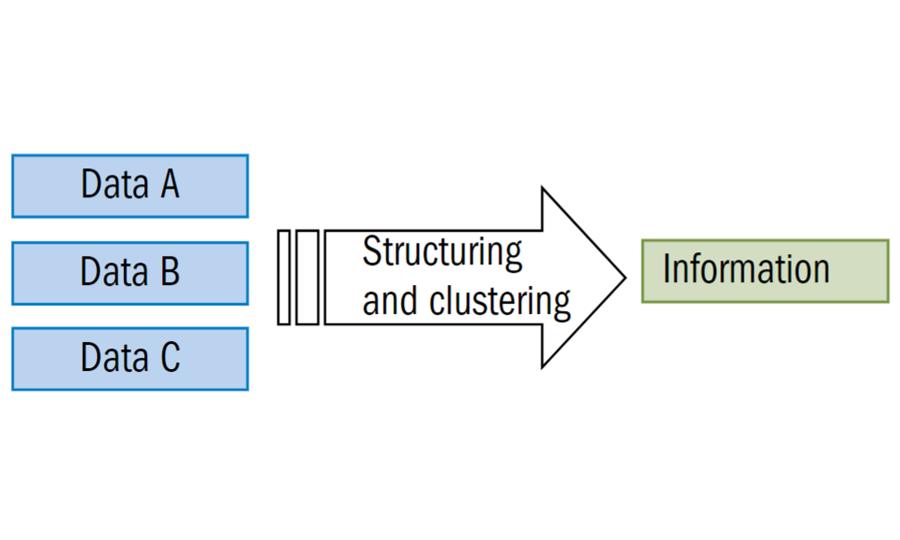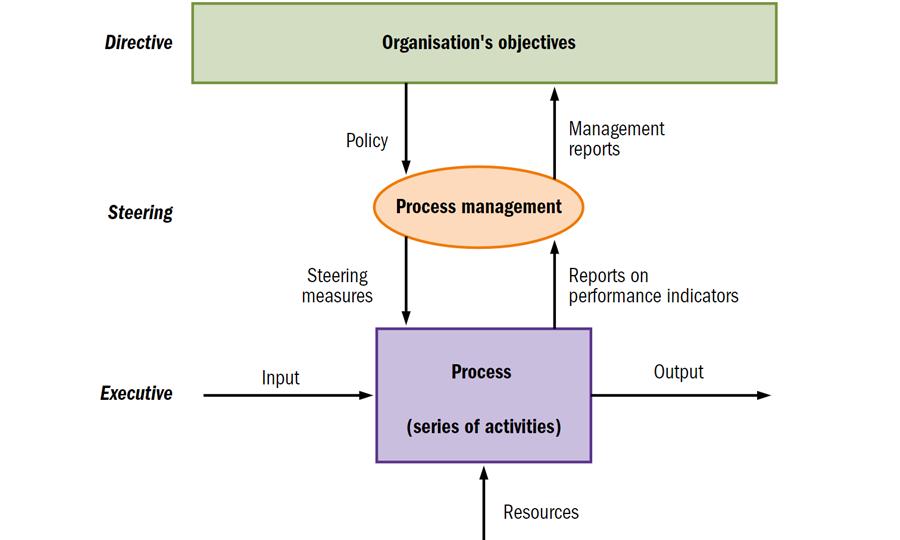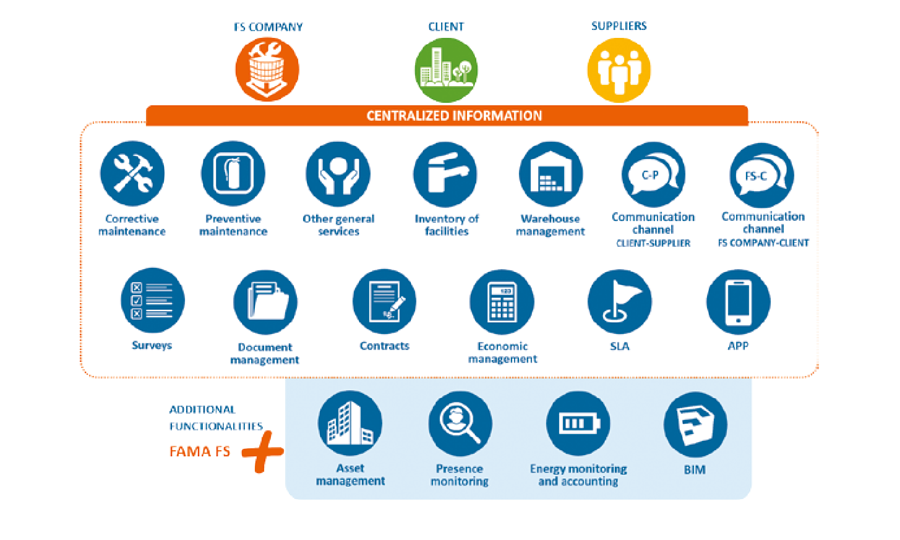This chapter discusses the many areas to which a facility professional should pay attention in managing the facility organisation. Information is needed for all these processes. Information management is hence the subject of this last section. There are various types of information. In this book we differentiate between operational information and management information. Operational information is information that is needed to keep the processes going and is also called process information. Management information is information that is needed to evaluate and adjust or improve the service.
4.10.1 From data to Information
You can record data and still have no information. Information consists of composed and structured data. To be able to use data tor management purposes, it must be organised in such a way that it actually tells you something (see Figure 4.20). A facility example: a stack of prints of all the reservations for meeting rooms is of no value to the manager of the meeting centre. These are just data. lt only becomes information when he knows what the average occupancy rate is per part of a day and whether there is a rising or falling trend.

Figure 4.20 From data to information
So, a manager needs information to be able to plan, steer and control. The manager's information needs are linked to the hierarchical level at which he or she operates. At the strategie level, relatively little (high-level) information is used to cover a wide range of matters. At the operational level, there is a need for extensive (detailed) information on relatively few subjects. For the management of the company, for example, one table may be sufficient to
show last month's sales figures. Although it contains little information, the table does show the total production result. At the operational level, spreadsheets are often used: for each machine, for example, the operating hours, maintenance intervals and the speed of production are recorded.
Other examples of information at operational level are the average occupancy rate of workplaces, average customer satisfaction with cleaning, number of complaints about indoor climate or downtime of installations.
| Information | Operational level | Management level
|
| Use | To ensure that day-to-day operations run smoothly, tor example, information about events (location, persons, attributes). | To support decision-making regarding the future ( e.g. identifying potential bottlenecks) |
| Period
| Short term
| Medium to long term
|
| For what?
| To control the process
| To be able to assess and adjust the process (e.g. KPls |
| For whom?
| lntended for operational staff
| Designed for managers at the operational, tactical or strategie level in the organisation |
Table 4.4 highlights the difference between operational information and management information.
As you can see, information from top to bottom is increasingly specific, and the information that goes from bottom to top is becoming less detailed. For this process to properly function, it is necessary to appoint process owners who are responsible for the process management. lt starts with the goals of the organisation on a strategy level. The objectives of the organisation are translated into strategy and policy. The policy gives direction as to how processes are configured. At the tactical level, consideration is given to related performance requirements for the operations. Control measures help to ensure that the right things are done in the right way. At the operational level, information is collected about the performance of the process (e.g. about speed, sustainability, quality). This information is provided in the form of process reports. At the tactical (management) level, data from many different processes are clustered in management reports, which indicate to what extent the organisation is on track in accomplishing its policy. Finally, this tactical management information is even further condensed to a strategy dashboard with only a few indicators to monitor the organisation's performance. In Chapter 5, this is discussed in more detail.
Figure 4.21 shows the connections between the various information flows.

Figure 4.21 Process diagram
4.10.2 Computer Alded Faclllty Management software (CAFM)
To be able to offer an excellent service it is essential to be 'in control'. The question is: who does what, how is it done, what does it cost, and what is the result? For a sound management system, an organisation needs an integrated set of tools that support its working methods. Computer Aided Facility Management Software (CAFM) is used to support work processes and management processes. Examples of CAFM are Facility Management Information Systems (FMIS) and lntegrated Workplace Management Systems (IWMS). In this way, CAFM supports being in control of the facilities organisation. CAFM is also used for the registration and handling of questions, reports and complaints, both by operational facility staff and for self-service by the end-users. CAFM has a modular structure, in which it is possible to expand the standard FMIS or IWMS with options that meet the wishes of the organisation.
Examples are modules for meeting room reservations, visitor registration and inventory management. CAFM is a stand-alone software system, which is ideally suited for integrated deployment. CAFM then plays a central role in the exchange of information with other systems or devices, for example, with smart sensors and the building information management system (BIMS). Smart sensors are able not only to detect an event but also to communicate it (through the Internet of Things). An example: a sensor monitors the temperature in a specific room. As soon as the temperature exceeds a minimum or maximum setpoint, the sensor communicates this with the system. This automatically creates a new work order for checking the installations. Thus, complaints can be solved before they are reported.
The number of (automatic) reports may increase, but the number of reports of complaints will decrease. We give another example. lf printers generate automated orders for new toners faster than average, the system will notice this. Based on this signal, you can consider whether the capacity of the printer is sufficient for local demand, or whether you need one with a higher capacity. These may seem straightforward applications, but big data analysis leads to new insights that will enable you to increase the quality of service and reduce costs. With smart systems, it is possible to make ever better predictions about customer behaviour, even in environments that are subject to change.
Well-known suppliers of FMIS/IWMS systems are Archibus, FAMAS, NPQ Prequest, Topdesk, Planen and Ultimo. Figure 4.22 shows an example of modules such a system can include.

Figure 4.22 Example modules of an FMIS/IWMS
Let's give an example of the functionality of CAFM. Suppose a customer wants to schedule a meeting. He needs a conference room for twelve people with a U-shaped set-up, a beamer, and a selection of refreshments.
The meeting will be attended by tour external guests who come by car, two of whom need a charging station. The customer contacts the service desk or logs on to the self-service portal and makes the request outlined above.
The service desk assistant will look into the conference room management module to see which meeting rooms are available. In consultation with the customer, a room is booked. The service employee then checks whether a standard beamer is available. lf not, the system reserves a beamer. It sends a message to the technical support that a beamer must be ready at the discussed time and location. Also, a request is sent to the conference service staff for refreshments and required set-up of the tables.
In the self-service portal, the customer enters the date, time and requirements concerning capacity and facilities. The reservation system then displays the available conference rooms that meet the criteria given. The customer reserves his preferred option, indicates the desired layout of the space and selects refreshments from a list of food and beverages. External guests are registered in the visitor registration module (either by the customer himself or by the service employee), and parking spaces are reserved for guests arriving by car, with or without a charging station. All reservations are confirmed by email. Service desk employees (and in case of self-service also customers) can check the status of the requests in the FMIS/IWMS.
For the customer, working with CAFM has the advantage of one-stop-shopping, and in the case of self-service, that he can arrange things at any time without delay. For the facilities organisation, this way of working means that the operational services are perceived as more customer-friendly and transparent. On a tactical level, management information can be retrieved from the system, such as the average occupancy rate of the meeting rooms and the average time between reporting and resolving a malfunction. Due to the central registration of all requests, notifications and reservations, work processes can be effectively coordinated. The following points of attention are essential in the implementation of CAFM:
- The work processes must be well structured and organised (see section 3.3.2).
- The organisation must accept working with CAFM. A system that does not fit in with the work processes of the organisation is ineffective, even if it is an excellent system. Therefore, always involve future users in establishing the programme of requirements and in the selection of a system.
The Boijmans Van Beuningen museum in Rotterdam now works with an FMIS. Given a major renovation and the opening of the new Boijmans Van Beuningen depot, the facilities department, the IT department, the technical department and the security department felt the need for tighter registration of incoming requests and complaints. Without a system, everything becomes elusive, and you are not in control. lt was necessary to get a better grip on the work and to be able to set priorities.
The selection process started with an inventory of requirements and wishes and the preparation of a programme of requirements. After the preselection, two suppliers were invited to demonstrate their system. The choice was made based on objective criteria and the expected quality of the coöperation.
The final decision was followed by a kick-off meeting with representatives of the museum and the supplier. Of course, there was already a significant degree of paperwork. But in such a meeting, you discuss what you expect from eachother and how you want to collaborate and communicate. Building the relationship is crucial; however, an often overlooked success factor.
Feedback component
How satisfied are you with the information on this page?